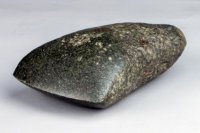Stone Axe
1968/24


Innovation
Aboriginal people were the first in the world to grind edges on stone tools like this axe blade. These tools were part of everyday life and used for a variety of tasks like chopping wood, processing animal skins and preparing food. 36,000- year-old grindstones used for making flour from seeds suggest that in addition to being innovative toolmakers, Aboriginal people are also likely to be the world’s first bakers.Manufacturing
This Aboriginal stone axe blade was found on the traditional lands of the Awarbukal people. It is a product of complex manufacturing techniques. The hard stone was picked to create an axe shape and then was polished on both sides with sand to create a precise straight sharp edge. The Awarbukal word for stone axe is bukko.Trade
This Aboriginal axe blade was found in the Hunter Region but is made of stone sourced in Central Victoria. Aboriginal nations developed complex trading routes over more than 60,000 years. These routes were not just used for exchanging goods but also for sharing knowledge and culture. The Awarbukal traded coal, that was used to treat psoriasis, and local stone called chert that was used for very sharp, almost scalpel-like blades.Greenstone
This piece of greenstone has been shaped into an axe blade. Greenstone is a type of Igneous rock formed through the cooling of magma or lava. Aboriginal people quarried the stone by striking exposed outcrops with a hammerstone, or by digging under or around them to find unweathered stone.


Stone Axe
1968/24


Innovation
Aboriginal people were the first in the
world to grind edges on stone tools like
this axe blade. These tools were part
of everyday life and used for a variety
of tasks like chopping wood,
processing animal skins and preparing
food. 36,000-year-old grindstones used
for making flour from seeds suggest
that in addition to being innovative
toolmakers, Aboriginal people are also
likely to be the world’s first bakers.
Manufacturing
This Aboriginal stone axe blade was
found on the traditional lands of the
Awarbukal people. It is a product
of complex manufacturing techniques.
The hard stone was picked to create
an axe shape and then was polished
on both sides with sand to create
a precise straight sharp edge. The
Awarbukal word for stone axe is bukko.
Trade
This Aboriginal axe blade was found
in the Hunter Region but is made
of stone sourced in Central Victoria.
Aboriginal nations developed complex
trading routes over more than 60,000
years. These routes were not just used
for exchanging goods but also for
sharing knowledge and culture.
The Awarbukal traded coal, that was
used to treat psoriasis, and local stone
called chert that was used for very
sharp, almost scalpel-like blades.
Greenstone
This piece of greenstone has been
shaped into an axe blade. Greenstone
is a type of Igneous rock formed
through the cooling of magma or lava.
Aboriginal people quarried the stone
by striking exposed outcrops with
a hammerstone, or by digging under
or around them to find unweathered
stone.



